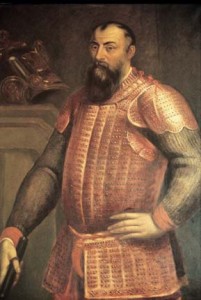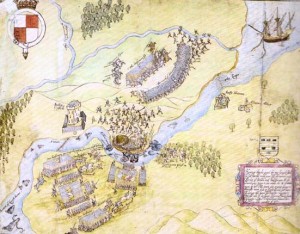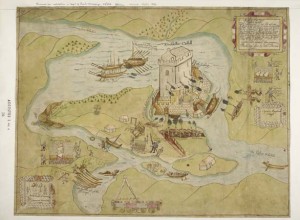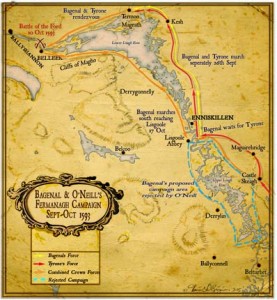Death in the lakelands: Tyrone’s proxy war, 1593–4
Published in Early Modern History (1500–1700), Features, Issue 2 (March/April 2015), Volume 23
Hugh O’Neill, earl of Tyrone. To what extent was he behind the rebellion of Hugh Maguire of Fermanagh before his open break with the Crown in February 1595? (Lord Dunsany)
At the beginning of the 1590s Ireland stood on the brink of a new era that would forever alter the economic, cultural and social characteristics of its people. The catalyst for these changes was the Nine Years War (1595–1603). In this period Gaelic military power reached its zenith, but it perversely ended with the completion of the Tudor conquest and the eradication of Brehon law, along with the traditional frameworks of native Irish power. Though the war appeared to burst into life when Hugh O’Neill, second earl of Tyrone, openly broke with the Crown in February 1595, the groundwork for Tyrone’s actions had been laid over the preceding two years.
There was already the kindling of conspiracies between Spain and Ireland in 1592–3, but the spark that ignited discontent into rebellion was the appointment of Captain Humphrey Willis as sheriff of Fermanagh in spring 1593. Hugh Maguire, lord of Fermanagh, responded by ejecting Willis from the county, but only after he was reinforced with troops from Tyrone. Maguire then launched two raids into Connacht. The first, in May, saw widespread spoiling in County Sligo. In June Maguire entered Roscommon with 1,000 troops. On 23 June Sir Richard Bingham engaged Maguire’s men in a confused mêlée in the fog near Rathcroghan, but Bingham’s small force was forced to break contact.
Bagenal and Tyrone’s Fermanagh campaign, Sept.–Oct. 1593

A contemporary map of its climax at the Battle of Beleek, 10 October 1593. (Tomás Ó Brogáin/British Library)
Bagenal’s only option was to continue northwards along the eastern shore of Lower Lough Erne. On 10 October the army approached the crossing near Belleek, which was fortified and held by 900 troops. The Irish position appeared strong, as the defenders occupied protective earthworks, but the long range of the English musketeers allowed them to pour withering fire into the flanks of the Irish. A determined assault by Bagenal’s infantry and Tyrone’s cavalry quickly sealed the issue and routed the defenders. Casualties for the attackers were exceptionally slight, given the difficult crossing and prepared defences, with only three soldiers killed and six wounded (including both Tyrone and Bagenal, who were slightly injured).
O’Neill returned to Dungannon but Bagenal remained. He wanted to extend the offensive north into Tyrconnell, but Sir Richard Bingham, the governor of Connacht, refused to support this course of action. Bagenal therefore spent the next week raiding along the southern shores of Lower Lough Erne, and by 17 October he was back at the ford at Lisgoole, where he found the Irish fortifications abandoned. Bagenal dissolved his army at Clones on 22 October, as the immediate threat was apparently neutralised and it was late in the campaigning season. In military terms the battle brought the autumn campaign to a satisfactory conclusion for Bagenal and Fitzwilliam. In their minds, and in reports to the privy council in London, the Irish rebels had been demonstrably defeated and ensuing intelligence supported their belief that they had broken Maguire’s power, but the troops routed at Beleek were not those who had held the ford at Lisgoole. In reality, Maguire’s forces were relatively unscathed by Bagenal’s efforts.
Battle of the Ford of the Biscuits

Contemporary map of Hugh Maguire’s stronghold at Enniskillen, taken by the English on 2 February 1594. While it may have seemed advantageous to have a strong position in the centre of Fermanagh, the upsurge of raiding along the Ulster borderlands left the Crown’s garrisons in a precarious situation. (British Library)
Led by Sir Henry Duke and Sir Edward Herbert, some 600 infantry and 46 horse (and possibly an equal number of camp followers and dependants) made their way north from Cavan on 4 August 1594. Three days later the army was attacked by Maguire and Cormac MacBaron at the ford of the Arney River, just over five miles south of Enniskillen. The head of the column was stalled by heavy fire from the northern riverbank, and the shaken centre and rear of the army quickly collapsed when assaulted by MacBaron’s pikemen. The shattered force attempted to rally on the northern bank after a pike charge pushed back the Irish shot, but Duke and Herbert knew that the only option was to break contact and retreat westwards to Sligo. The fugitives were saved as the Irish fell to looting the baggage train, which gave the battle its name, the Ford of the Biscuits.
Despite the defeat of the relief expedition, the ward at Enniskillen held. When Sir William Russell, the new lord deputy, landed in Dublin, he was unexpectedly confronted with the arrival of Tyrone, offering all possible assistance to revictual Enniskillen. After an uneventful twelve-day march via Breifne, Russell reached Enniskillen. This was through country that had recently been described as in a state of undeclared war. Ominously for Russell, despite the peacefulness of the march none of his scouts returned, and none of his messengers sent to the ward arrived or were heard from again. Nevertheless, the easy progress of the mission convinced Russell to cancel the dispatch of 2,000 reinforcements from England, but prevarication, broken promises and the stationing of troops along the southern borders of Ulster caused Russell to lose patience with Tyrone. Over the winter of 1594–5 relations worsened, until Tyrone entered into open warfare with the Crown with the taking of the Blackwater Fort on 16 February 1595.
Strategic deception
It is possible to see the previous two years as a slow escalation to the point where war was inevitable, but the style of Irish military operations in 1593–4 suggests that the war in Fermanagh was consistent with the use of strategic and operational deception by Tyrone and his allies later in the war. In fact, the defining feature of Irish military operations in 1595–8 was strategic deception and misdirection of Crown forces. Wherever there was fighting or a concentration of government forces, Tyrone and his allies were making significant political and territorial gains elsewhere. In 1595 Tyrone compelled English military power to be focused on supplying the forts in Armagh and Monaghan; meanwhile, Tyrone’s allies began to dominate much of Connacht. The following year Lord Deputy Russell was provoked into a fruitless pursuit of Feagh McHugh O’Byrne in Wicklow; meanwhile, much of the Pale and the midlands were overrun. Tyrone’s blockade of Armagh in 1597 was not an attempt to take the fort but a successful ploy to draw the Crown’s army out of Connacht, leaving the province wide open for O’Donnell to move south unopposed. In retrospect, the campaign in Fermanagh followed the same pattern.
While the queen’s officers were fighting in Fermanagh, Tyrone’s adherents threatened, raided and in some cases assassinated Irish lords in Ulster who were loyal to the Crown. The raids undermined the political power and influence of the nobles whose lands had been pillaged, and served to demonstrate the Crown’s military weakness to their Irish clients who looked to them for support. Their loyalty was predicated on the English ability to protect them, but with government forces preoccupied no help came. Despite repeated requests for support against raids by Art Mac Baron O’Neill, the lord deputy had no men to send. The Magennises of Iveagh and O’Hanlons of Orior were forced to swear fealty to Tyrone, and even staunch allies of the Crown such as Niall MacBrian Fertagh O’Neill in Ards and Conor Roe Maguire in Fermanagh eventually succumbed to the reality of Tyrone’s dominance in Ulster.
Maguire’s rebellion normally forms a preamble to the earl of Tyrone’s open revolt and the main events of the Nine Years War. In reality, the war in Fermanagh represents the opening shots of that war. The fighting in the lakelands was part of a sophisticated plan of deception, which granted Tyrone almost two years to prepare before he overtly broke with the Crown in 1595. Maguire’s war in Fermanagh facilitated a wider objective of military, economic and political primacy in Ulster. It was only when Lord Deputy Mountjoy broke into Ulster in 1600 that the edifice of Tyrone’s power started to collapse.
James O’Neill is a post-doctoral research fellow in the School of History, University College Cork.
Read More: Tyrone’s complicity: no smoking gun?
Further reading
W.T. MacCaffrey, Elizabeth I: war and politics 1588–1603 (Princeton, 1992).
J. McGurk, The Elizabethan conquest of Ireland: the 1590s crisis (Manchester, 1997).
H. Morgan, Tyrone’s rebellion: the outbreak of the Nine Years War in Ireland (Woodbridge, 1993).

















